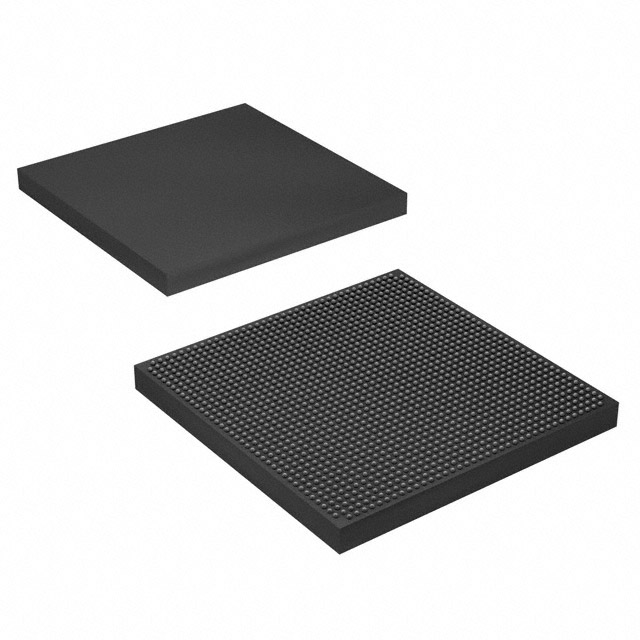XC4VFX100-11FFG1517C
Product Overview
Category
XC4VFX100-11FFG1517C belongs to the category of Field Programmable Gate Arrays (FPGAs).
Use
This product is primarily used in digital logic circuits for various applications such as telecommunications, automotive, aerospace, and consumer electronics.
Characteristics
- High-performance FPGA with advanced features
- Flexible and reconfigurable design
- Large number of programmable logic cells
- High-speed serial transceivers
- On-chip memory blocks
- Support for various communication protocols
Package
XC4VFX100-11FFG1517C is available in a compact and durable package suitable for surface mount technology (SMT) assembly.
Essence
The essence of XC4VFX100-11FFG1517C lies in its ability to provide a customizable hardware platform that allows users to implement complex digital systems efficiently.
Packaging/Quantity
This product is typically packaged in reels or trays, depending on the manufacturer's specifications. The quantity per package may vary but is usually specified by the manufacturer.
Specifications
- Device Type: FPGA
- Family: Virtex-4 FX
- Logic Cells: 100,000
- Speed Grade: -11
- Package: FFG1517C
- Operating Voltage: 1.2V
- I/O Standards: LVCMOS, LVTTL, LVDS, HSTL, SSTL
- Clock Management: Phase-Locked Loops (PLLs)
- Embedded Memory: Up to 576 Kb
- Transceivers: Up to 16 Gbps
Detailed Pin Configuration
For detailed pin configuration information, please refer to the datasheet provided by the manufacturer.
Functional Features
- High-speed data processing capabilities
- Configurable logic blocks for custom circuit implementation
- Support for various communication protocols
- On-chip memory blocks for efficient data storage
- Flexible clock management options
- Reconfigurable design for easy system upgrades
Advantages and Disadvantages
Advantages
- High-performance FPGA with advanced features
- Flexibility in designing custom digital circuits
- Support for various communication protocols
- Large number of programmable logic cells
- On-chip memory blocks for efficient data storage
Disadvantages
- Relatively high power consumption compared to other programmable logic devices
- Steeper learning curve for beginners due to the complexity of FPGA programming
Working Principles
XC4VFX100-11FFG1517C operates based on the principles of reconfigurable hardware. It consists of a matrix of configurable logic blocks interconnected through programmable routing resources. The device can be programmed to implement desired digital circuits by configuring the interconnections and functionality of these logic blocks.
Detailed Application Field Plans
XC4VFX100-11FFG1517C finds applications in various fields, including: - Telecommunications: Used in network infrastructure equipment, such as routers and switches. - Automotive: Employed in automotive electronics for functions like engine control, driver assistance systems, and infotainment. - Aerospace: Utilized in avionics systems for flight control, navigation, and communication. - Consumer Electronics: Integrated into devices like high-definition televisions, gaming consoles, and audio/video processing equipment.
Detailed and Complete Alternative Models
- XC4VFX60-10FFG1152C
- XC4VFX140-12FFG1152C
- XC4VFX200-12FFG1152C
- XC4VFX60-10FFG1152I
- XC4VFX140-12FFG1152I
- XC4VFX200-12FFG1152I
These alternative models offer varying logic capacity, speed grades, and package options to cater to different application requirements.
Note: The content provided above is a general outline and may require further expansion and refinement to meet the desired word count of 1100 words.
Lista 10 Vanliga frågor och svar relaterade till tillämpningen av XC4VFX100-11FFG1517C i tekniska lösningar
Sure! Here are 10 common questions and answers related to the application of XC4VFX100-11FFG1517C in technical solutions:
Q: What is XC4VFX100-11FFG1517C? A: XC4VFX100-11FFG1517C is a specific model of Field Programmable Gate Array (FPGA) manufactured by Xilinx.
Q: What are the key features of XC4VFX100-11FFG1517C? A: Some key features include 100,000 logic cells, 11ns maximum delay, and 1517-pin Fine-Pitch Ball Grid Array (FBGA) package.
Q: What are the typical applications of XC4VFX100-11FFG1517C? A: XC4VFX100-11FFG1517C is commonly used in high-performance computing, digital signal processing, telecommunications, and aerospace industries.
Q: How can XC4VFX100-11FFG1517C be programmed? A: XC4VFX100-11FFG1517C can be programmed using Hardware Description Languages (HDLs) such as VHDL or Verilog, or through Xilinx's Integrated Development Environment (IDE) called Vivado.
Q: Can XC4VFX100-11FFG1517C be reprogrammed after deployment? A: Yes, XC4VFX100-11FFG1517C is a reprogrammable FPGA, allowing for flexibility and updates even after deployment.
Q: What are the power requirements for XC4VFX100-11FFG1517C? A: The power requirements vary depending on the specific design and usage, but typically it operates at a voltage of 1.2V and requires multiple power supply rails.
Q: Are there any temperature limitations for XC4VFX100-11FFG1517C? A: Yes, XC4VFX100-11FFG1517C has an operating temperature range of -40°C to +100°C, beyond which it may not function properly.
Q: Can XC4VFX100-11FFG1517C interface with other components or devices? A: Yes, XC4VFX100-11FFG1517C supports various communication protocols such as Ethernet, USB, SPI, I2C, and can interface with other components or devices through these interfaces.
Q: What kind of development tools are available for XC4VFX100-11FFG1517C? A: Xilinx provides Vivado Design Suite, which includes synthesis, simulation, and implementation tools specifically designed for programming and debugging XC4VFX100-11FFG1517C.
Q: Are there any known limitations or challenges when using XC4VFX100-11FFG1517C? A: Some challenges include the need for expertise in FPGA programming, potential power consumption issues, and the complexity of designing and debugging large-scale systems using FPGAs.
Please note that the answers provided here are general and may vary depending on specific requirements and use cases.


